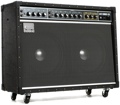
The 1980s were a landmark decade of experimentation and technological innovation marked by voluminous hair, outlandish guitars, refrigerator-size effects racks, and larger-than-life musicians.
But, beyond its leopard-print pants and era-defining antics, the 1980s left behind three distinct tonal flavors guitarists today still can’t get enough of: the Clean, the Crunch, and the Lead. We’ll break down the gear and techniques used to achieve these sounds and why they’re coming back in a big way.
The ’80s Clean
The compressed and shiny clean tones of the 1980s can be found everywhere today from Harry Styles’s “As It Was” to the Weeknd’s “Out of Time.” The ’80s clean tone is perfect for adding a percussive touch and extra shimmer to any arrangement.
For me, the ultimate ’80s clean tone is a quacky, in-between Strat tone served up with a generous side of compression. You can hear it on The Blow Monkeys’ “Digging Your Scene.”
Guitar
Unlike other tones, the ’80s clean tone requires a specific style of guitar. The Fender Stratocaster is the obvious choice. But as long as you’re using single-coils and have a guitar with a 5-way switch, you’re good.
For a perfect ’80s clean tone, you’ll primarily use positions 2 and 4. Position 2 engages the bridge and middle pickups for the classic “out-of-phase” sound heard on “Sultans of Swing.” Meanwhile, position 4 uses the neck and middle pickups for the “quack” tone.
Amp
You can build an ’80s clean tone two ways: with an amp or by running directly into a DAW.
If you’re recording in the studio, then you’ll want to do it how they did it in the ’80s — by plugging straight into the board. Bypassing the amp and speaker gives you that squeaky-clean tone.
For playing live, you’ll want an ultra-clean amp such as the Roland JC-120 Jazz Chorus (or its little brother, the JC-40). The Jazz Chorus is a legendary pedal platform with a lush onboard stereo chorus. Because it doesn’t color your signal, pedals and effects do the heavy lifting.
If you’re searching for a modern app that can do ’80s cleans, then the Fender Mustang GTX 100 gives you onboard effects and app control to dial up the perfect ’80s preset.
Effects
Guitarists in the ’80s didn’t have access to the vast selection of guitar pedals we enjoy today. Many relied on outboard gear in the studio and simple pedals to try to replicate those tones onstage.
Today, you can place a rack-style compressor squeezed into a pedal format, such as the Origin Effects Cali76, in the effects loop of your amp to achieve that not-so-subtle flattening.
Once your attack is sufficiently squashed, it’s time to spread on the final coat of gloss in the form of chorus, harmony, and delay. Eventide’s TriceraChorus is purpose-built for this sound, thanks to its MicroPitch detune effects. You can build that swirling chorused sound with the legendary BOSS CE-2 or the JHS 3 Series Chorus. A subtle delay effect from a TC Electronic Flashback 2 combined with detuning from a BOSS PS-6 will do wonders to widen your tone further. Finally, try a Strymon BigSky reverb last in the chain for an expansive ’80s guitar tone!
The ’80s Crunch
Next, we examine the 1980s crunch sound. While countless fantastic rhythm tones came out of this era, I’m choosing Kenny Loggins’s “Danger Zone” as the decade’s crunch exemplar. The rhythm line takes the compressed and chorused goodness of the ’80s clean tone and roughs it up with more grit.
Guitar
For crunch, the guitar you use is up to you. Single-coils, humbuckers, or P-90s — all can be used with equal success. However, humbuckers tend to give you a little extra midrange push, which is on target for the era’s crunch sounds.
If you’re searching for an absolutely authentic ’80s vibe, then a humbucker-equipped superstrat with an aftermarket trem is perfect.
Amp
Getting the right balance of gain and headroom is essential when selecting an amp. Of course, you can’t go wrong with a Marshall DSL100HR or a Soldano SLO-100 as those amps were ever-present in the mid-’80s LA scene.
Of course, you can’t forget the iconic Mesa/Boogie Mark Series amps! Just turn up the gain until the amp delivers the roughed-up edge you want.
Effects
You’ll probably need to sculpt all that extra gain you just dumped into your signal. As with the ’80s clean tone, a compressor, such as the dbx 160x, must be in the effects loop for proper ’80s crunch.
Placing an EQ after the compressor is great for shaping your tone. I’ve produced magical results by scooping the mids on the EQ and diming them on the amp. It’s squeezed to perfection yet sculpted to my personal needs. Add a Walrus Audio Julianna or another wide stereo chorus to liven things up before the reverb and delay.
Of course, pedals aren’t the be-all, end-all of ’80s crunch effects! You can get those sounds from plug-ins, as well. Eventide offers the TriceraChorus vintage tri-chorus and the Octavox diatonic pitch shifter in plug-in formats. Waves’ dbx 160 plug-in also effortlessly delivers the compressed sound. Other plug-ins from Arturia, Soundtoys, and Lexicon can help you nail those tones, as well.
The ’80s Lead
The ’80s’ instantly identifiable artifact has to be its huge, uber-processed lead tones. Essentially, the ’80s lead ups the ante on the crunch tone with at least one extra delay, a pitch shifter, and an optional sustainer.
Though there are many iconic lead tones to choose from, I’m going with the guitar solo from Michael Jackson’s “Beat It” played by the late, great Edward Van Halen.
Guitar
If you’re going to play ’80s lead guitar, then you need an axe that looks and sounds the part. You can’t go wrong with an EVH Striped Series Frankenstein. Superstrat players may consider a Jackson Pro Series Soloist SL3M for its high-octane looks and playability.
Although the Les Paul had yet to make a full comeback by the 1980s, guitarists like Slash and Ace Frehley were rocking them worldwide.
Whichever model you choose, just be sure you have a humbucker in the bridge — other pickups are optional.
Amp
Sticking with the classics is essential when you’re talking ’80s lead tones. There’s really just one option for the amp: the Marshall JCM800. Packing 100 watts of power and several stages of cascading tube gain, these amps were all over 1980s radio.
I’ve included the EVH 5150IIIS for good measure since it was Eddie’s main tour amp until the time of his passing. Who can question that?
Effects
Take your crunch tone and crank the gain even further for a fantastic lead tone. If pushing your power tubes into breakup risks damaging your hearing, then you can substitute the amp’s gain with a Tube Screamer or Wampler’s Plexi-Drive.
The trick to nailing this tone is to feed the signal through two delays simultaneously. Set a short time on one and a longer time on the other for a huge, stadium-filling effect. You can use the same delay pedals and effects plug-ins mentioned above. Or you can be adventurous with Keeley’s Compressor Pro, Eventide’s PitchFactor and H9, or the Meris Mercury7 reverb.
Would you rather augment your tone with outboard gear? Then you’ll love the Lexicon PCM96 stereo reverb and effects processor. Use a BBE Sonic Maximizer with a dbx 1231 EQ to make your tone cut through the mix with surgical precision. And, if you want ’80s goodness in a single piece of gear, go with the Eventide H9000 multichannel effects unit. It has every ’80s tone and then some.
The ’80s Tones Live On!
While the Aqua Net, animal prints, and theatrics of the 1980s have mostly disappeared from music today, the carefully crafted tones of the decade are still kicking. Whether you’re looking for crystalline cleans, crunchy riffs, or liquid leads, Sweetwater has the gear you need to make it happen. Call your Sweetwater Sales Engineer at (800) 222-4700, and they’ll help design the ’80s-inspired guitar rig you’re dreaming of.














